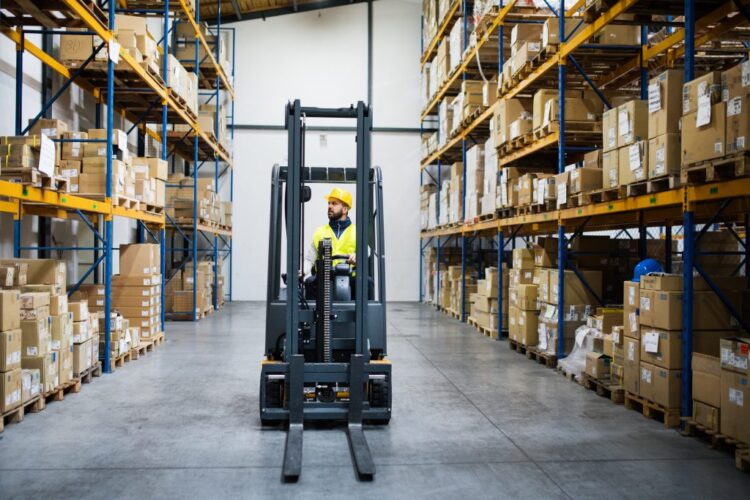Forklift tip-overs are among the top safety concerns in industrial environments where the use of material handling equipment is prevalent. When operating forklifts in Toronto or the GTA, drivers need to follow certain safety precautions to reduce the risk of an accident. In-depth and ongoing forklift training is an absolute necessity. Keep reading to learn about how to safely operate forklifts.
What Causes a Forklift to Tip Over?
A forklift tip-over is exactly what it sounds like. It’s when a forklift leans a little too heavily on one side and falls to the ground, usually as a result of uneven weight distribution from a heavy load.
There are a lot of different factors that can lead to a forklift tip-over. Here are some of the most common ones that forklift dealers in Toronto come across.
The Center of Gravity Is Off-Balance
The center of gravity of the forklift is relative to the positioning of its various parts. The fulcrum, which is the base, has to be in the middle and the loads on each side should have equal weight distribution to maintain stability. If one side is heavier than the other, then the entire mechanism will be thrown off balance and the forklift will tip over.
Exceeding the Load Capacity Limit
Manufacturers typically include forklift load limits in the accompanying manuals so operators and warehouse managers are aware of the weight restrictions of the equipment. Exceeding the recommended load limit can overwork the forklift, accelerate wear and tear, and cause it to malfunction or tip over. The forklift will tip over according to the side the load is located on.
Carrying an Unbalanced Load
Forklift masts are located at the front of the machine. If the load on the mast is too heavy, then this can cause the entire forklift to lean forward and tip over. Lifting and lowering loads on a slight or steep downward slope can also throw the forklift’s entire center of gravity off-balance and cause it to tilt forward and tip over.
Improper Turning with a Load
Operators need to be extremely careful when turning a corner while carrying a load on the side or front of the forklift. Large loads can obstruct their line of vision. A spotter is required to safely direct the operator and prevent them from bumping into objects and structures and ensure that there’s enough room to turn a corner safely and slowly. Going around a corner too quickly can make the load jerk to one side, which can cause the forklift to tip over.
Driving on Uneven Ground
Traversing (riding on an angle to aid in ascension or descension) a steep uphill or downhill slope while carrying a load isn’t just impractical, it’s also incredibly dangerous for the forklift operator and anyone else in close proximity. The safest way to approach an uphill or downhill slope is to drive straight rather than diagonally or on an angle. Depending on the steepness of the slope, lightening the load capacity can make the maneuver easier and reduce the risk of tip-over as long as the operator drives the forklift in a slow and controlled manner.
Turning a Corner Too Quickly on a Slope
Corners and slopes are tricky enough for forklift operators to safely navigate on their own. But when you’re trying to do both at the same time, the level of risk increases significantly. Turning a corner that’s located on an uphill or downhill slope should be done with the utmost care. Moving too quickly can cause the bulk of the load to shift to one side and this can cause the entire mechanism to tilt and tip over.
Driving Too Fast and Braking Abruptly
The faster the vehicle is moving, the harder the operator will have to brake to get it to stop when faced with an obstacle. Hard braking accelerates mechanical wear and tear and also causes the load to forcefully shift forward and then backward on impact, which can lead to a tip-over.
How to Prevent Forklift Tip-Overs
With proper forklift training, maintenance, and maneuvering, tip-overs are completely preventable.
Provide Ongoing Forklift Operational Training
All forklift operators should receive consistent and ongoing forklift operational training according to Canadian Centre for Health Occupational and Safety (CCHOS) regulations. Industrial and commercial work safety standards are updated regularly to ensure the well-being of all onsite workers. Operators should undergo forklift safety training every couple of years to renew their licenses and ensure they know how to prevent and respond in case of a malfunction, accident, or tip-over.
Ensure Even Weight Distribution
Load capacities on forklifts should be evenly distributed to prevent the equipment from tilting and tipping over.
Know the Difference between Gross and Net Weight
Gross weight includes the weight of the inventory, packaging, and the pallet. It’s important to know the combined weight of these components to prevent overloading the forklift and exceeding the manufacturer’s recommended load capacity.
Net weight only takes the weight of the load itself into account for inventory that doesn’t have any packaging or doesn’t require a pallet.
Perform One Operation at a Time
Avoid multitasking when operating a forklift. It’s best to focus on one task at a time and do it correctly and safely rather than trying to perform multiple operations simultaneously and jeopardizing the safety of everyone around you. Doing too much all at once can overwhelm the forklift’s weight capacity and shift its center of gravity too far in one direction.
What to Do if a Forklift Tips Over
Your first instinct might be to immediately exit the cab of the forklift and try to flip it over from the side that’s on the ground. However, this is a bad decision. Pushing the forklift too hard from one side can cause it to move too quickly in the opposite direction or simply fall back down and risk crushing a worker on either side. Here are the proper safety and recovery procedures to follow if your forklift tips over:
- Remain in your seat
- Keep your seatbelt securely fastened
- Firmly grip the steering wheel with your hands for stability
- Use your body weight to push in the opposite direction of the fall
- Call for help
Get Certified Forklift Training from a Forklift Dealer in Toronto
A forklift tip-over can be extremely nerve-wracking, especially for inexperienced operators. Preparation and proper forklift training in Toronto are your best line of defense to help you stay calm in this situation. The mechanical engineers and experts at NovaLift Equipment Inc. provide in-depth forklift repairs, maintenance, and safety training to prepare operators for worst-case safety scenarios. Contact us today to learn more.


